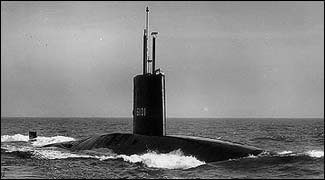|
HMS Dreadnought S-101, Royal Navy’s first nuclear powered submarine
 The introduction of nuclear powered submarines marked a huge leap forward in submarine warfare for the Royal Navy. Dreadnought, the Royal Navy’s first nuclear powered submarine, entered service in 1963. The nuclear propulsion allowed submarines to succeed where earlier boats had failed, as true fleet submarines fast enough to protect a convoy or task force and scout ahead of the main fleet. Their ability to remain submerged without having to surface for air gave them an immediate advantage over smaller conventional submarines and the mere presence of these submarines could be enough to deter aggression. The introduction of nuclear powered submarines marked a huge leap forward in submarine warfare for the Royal Navy. Dreadnought, the Royal Navy’s first nuclear powered submarine, entered service in 1963. The nuclear propulsion allowed submarines to succeed where earlier boats had failed, as true fleet submarines fast enough to protect a convoy or task force and scout ahead of the main fleet. Their ability to remain submerged without having to surface for air gave them an immediate advantage over smaller conventional submarines and the mere presence of these submarines could be enough to deter aggression.
Research into the possibility of developing nuclear powered submarines began in Britain at the end of the Second World War. However, it was the Americans who took the lead, launching the world’s first nuclear powered submarine, the USS Nautilus, in 1954. In order to keep up with the pace of technology, the Royal Navy was eager to develop atomic powered submarines of their own. In 1954 a naval section was set up at the Atomic Research Station at Harwell and in 1958 a land based prototype of a submarine reactor was constructed at Dounreay in Scotland. However the development of a British nuclear reactor was taking some time and in order to keep to budget and to schedule an agreement was reached in 1958 with the United States whereby a reactor based on the USS Skipjack design, was built by Westinghouse in America and incorporated into a British designed bow. This agreement between the UK and USA was largely made possible thanks to the close relationship between Lord Mountbatten (First Sea Lord between 1955 and 1959) and Admiral Hyman Rickover, mastermind of the US nuclear submarine project. American expertise and experience was leant to Vickers and Dreadnought was completed earlier than expected.
Dreadnought’s hull was based on the streamlined `teardrop design` of the USS Albacore, although her hydroplanes were positioned at the bow rather than on the fin. Measuring 80.8 meters in length and 9.7 meters in beam, she displaced 3,000 tons, which is small by comparison to later nuclear submarines. With a complement of 113 officers and men, greater emphasis was placed on crew comfort than with other submarines particularly because of the long periods of time which would be spent submerged. The design emphasized speed to a greater extent than quietness: she had a distinctive whale shaped casing and a fin shaped conning tower, both of which helped to reduce drag. Dreadnought`s principle role would be to detect and destroy enemy submarines (hence the term `hunter-killer`) and she was fitted with six forward torpedo tubes.
The keel of Dreadnought was laid at Vickers’s Barrow-in-Furness yard on the June 12, 1959; she was launched by HM the Queen on Trafalgar Day, October 21st, 1960. Dreadnought embarked on a series of extensive sea trials, she was finally completed on 17th April 1963.
In 1967 Dreadnought sailed from Rosyth to Singapore and back again, travelling 4,640 n/miles surfaced and 2654 miles submerged. She entered a refit at Rosyth Dockyard in 1967 which included a nuclear refuel and recommissioned on September 10th 1970. The following year she became the first British submarine to surface at the North Pole. Under the command of Cdr Alan Kennedy she traveled 1,500 miles under the ice before breaking through the surface on March 3rd 1971.
Between 1974 and 1976 she underwent a second refit which included another refuel. In November 1977 Dreadnought was deployed to the Falkland Islands as part of a secret taskforce which included the frigates Alacrity and Phoebe and the auxiliaries Resource and Olwen. The mission- codenamed Operation Journeyman - was designed to deter Argentine aggression and prevent a feared invasion of the South Atlantic Islands. To this day there remains some debate and speculation as to weather Dreadnought was given orders to expose herself to the nearest Argentine vessel or whether her presence was leaked in Buenos Aires by British intelligence.
Compared with newer submarines, Dreadnought was smaller and noisier and towards the end of the 1970s she began to suffer from a number of technical problems and was withdrawn from service in 1981. Although laid up at Chatham in 1982, the closure of this base prompted her relocation to Rosyth. She was towed to the Scottish Dockyard on April 13, 1983 and remains there today.
Specifications, HMS Dreadnought/ Dreadnought class:
The first British nuclear submarine with an American, Westinghouse, nuclear reactor and a ‘teardrop hull’. Laid down by Vickers-Armstrong, Barrow, on June 12, 1959; launched October 21, 1960 and commissioned April 17, 1963.
Displacement (srf/sub tons): 3,500/4,000
Dimensions (L*B*D feet): 265`7*31`2*25`9
Propulsion: Westinghouse S5W Pressurized Water Reactor (PWR) 15,000hp, 2*GEC geared steam turbine, one screw
Speed (sub knots): 30
Range (srf/sub miles@knots): not relevant
Diving depth (feet): 1000
Complement: 11 officers 77 enlisted
Missile: none
Torpedo: 6*21" (533 mm) bow torpedo tubes, total of 30 torpedoes Mk VII later on Mk-23.
Armament: none
Mines: none
Construction
A class of one boat was ordered from Vickers Shipbuilding & Engineering Ltd (VSEL).
 |
Gibraltar |
1967 |
HMS Dreadnought |
 |
Uganda |
2001 |
HMS Dreadnought |
 |
Saint Kitts & Nevis |
2001 |
HMS Dreadnaught 1960 |
|